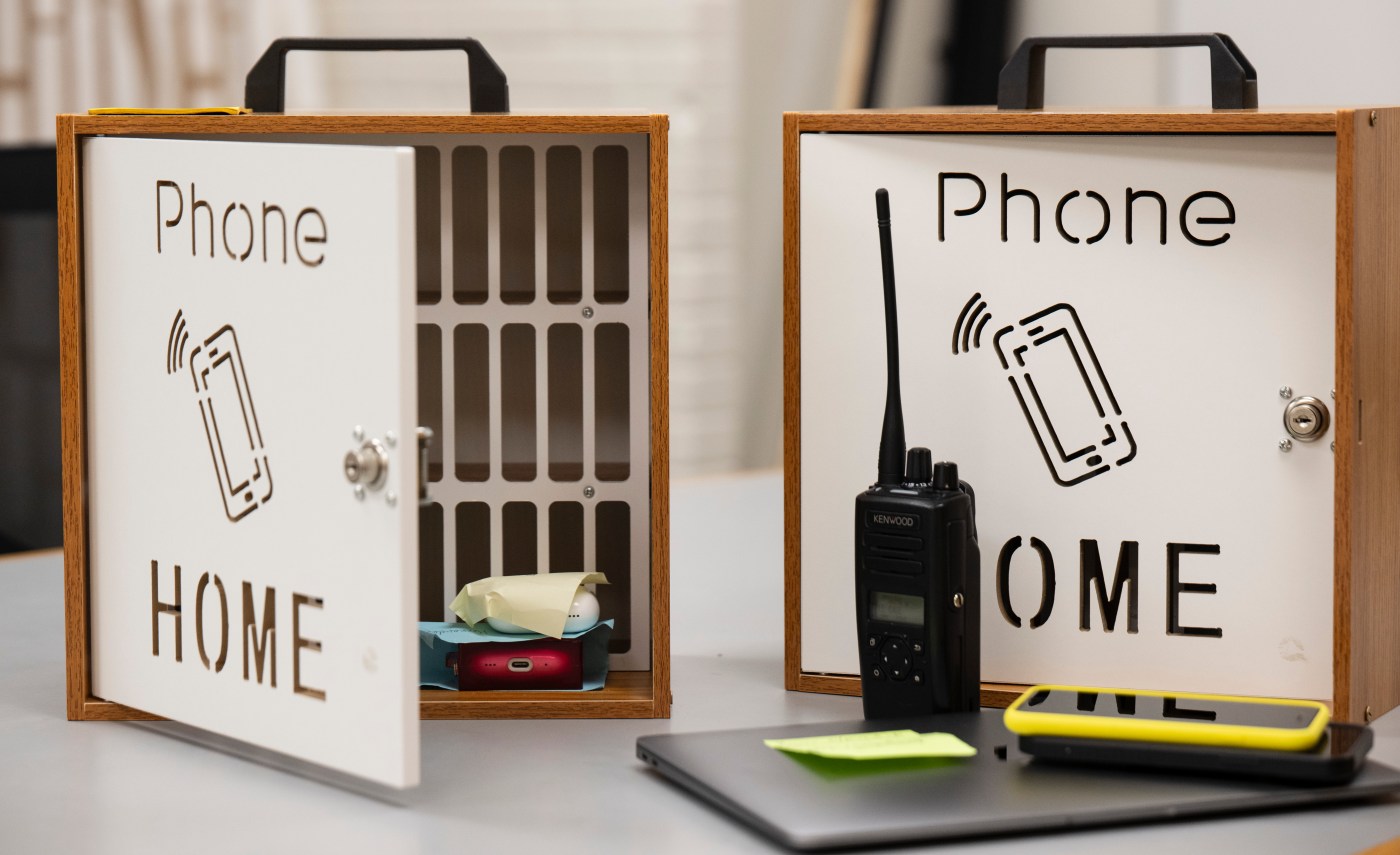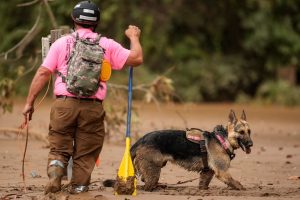
As St. Paul district considers cellphone limits, some schools are putting them away
When students enter Josiah Hill’s classroom at Stillwater Area High School, they leave their cellphones in the pockets of a fabric caddy that hangs on the wall.
In the last 15 years, Hill, who teaches the 10th and 12th grades, said he’s seen the prevalence of cellphones in school skyrocket.
“School districts, early on, I don’t think were very well equipped on how to manage this, especially when they kind of exploded in use and became nearly universal. And oftentimes, it would lead to conflict if a cellphone was becoming a distraction in class,” Hill said.
While the caddies are used in every Stillwater Area High School classroom, more school districts are adopting district-wide policies on cellphone use since they were mandated to do so by the state Legislature in April. The deadline for districts to set school board-approved policies is March 15.
RELATED: MN Legislature: Classroom cellphone restrictions, a ban on book bans passed this session
As part of the legislation, a best practices guide called “The Cell Phone Toolkit” was developed by the Minnesota Elementary School Principals Association and the Minnesota Association of Secondary School Principals and released in July.
Nayomi Gates, a freshman at Creative Arts Secondary School, talks about the student cell phone policy at the St. Paul school on Thursday, Sept. 26, 2024. (John Autey / Pioneer Press)
The guidelines recommend no cellphone use during the academic day for elementary and middle schoolers and no use — except perhaps during passing time and lunch — for high schoolers.
Each district gets to decide what, if anything, they want to follow from the toolkit, said Hill, who also is a state lawmaker who co-authored the policy mandate.
“When the research pointed out that the removal of these devices creates benefits around student behavior, improves mental health and enhances academic attainment, that caught my attention real quick,” Hill said. “Those are three things that will benefit our young people, and anytime we can find ways to benefit our young people, I’m interested in learning how to approach that in the best possible way.”
Many schools already have procedures in place for cellphone usage, but not necessarily school board-approved policies, according to Deb Henton, executive director of the Minnesota Association of School Administrators.
Because the legislation doesn’t say what has to be in each district’s policy, districts can engage with more local voices as they write the rules, she said.
The benefits
Hill said he’s seen students more engaged and positive since he started using the phone caddy in his classroom, and some students have told him they like it.
Leaving cellphone policies and enforcement up to each teacher presents challenges, Hill said.
“Trying to get the student to turn over their phone if they violated that teacher’s classroom policy, would, at times, lead to conflict, and then other entities in the school would have to be utilized. It was a pretty big drain on resources,” Hill said.
While listening to testimony on the bill, Hill also heard of conflict between colleagues due to cellphones.
Principal Kristen Lynch talks about the student cell phone policy at Creative Arts Secondary School in St. Paul on Thursday Sept., 26. 2024. (John Autey / Pioneer Press)
“A teacher maybe would feel less than supported by an administrative colleague to help manage this situation, or an administrative colleague might feel frustration that maybe a teacher had a lax policy compared to what the expectation was,” Hill said. “And that then puts pressure on other teaching colleagues.”
St. Paul’s Creative Arts Secondary School, which enrolls about 390 students from grades 6 through 12, requires students to leave phones in their lockers for the entire school day. That ideally removes teachers from the issue entirely, Principal Kristen Lynch said.
She’s seen the policy alleviate some of the bullying tied to phone use and seems to have led to a reduction in fights and truancy.
Student, administrative response
Creative Arts sophomore William Wells and freshman Nayomi Gates said the St. Paul school’s policy is working well.
“The cellphone policy is different from the last two years I was here, but it’s better because not many kids would talk to each other, especially during lunchtime,” Gates said. “We would always have our phones, just be on our phones, and I feel like (now) we have more interactions and we can talk and meet new people.”
The expectation leaves no gray area — phones need to be in lockers, Lynch said. Phones confiscated from students are kept in a room where students can pick them up at the end of the school day. In the case of repeat offenders, a parent has to pick up the phone.
“I’ve gone into classes and seen every single kid paying attention, and I can’t tell you since COVID at least when that’s ever happened,” Lynch said.
“We want to grow good humans while we’re here and have them ready for life after high school and just to be awesome when they leave. And in order to be able to do that, we got to do this. We’ve got to talk to each other and not (our phones) all the time,” she added.
Different schools, different expectations
At Hill-Murray School, the private Catholic school in Maplewood with around 1,060 secondary students, federal grants have covered the school’s purchase of Yondr pouches that students use to magnetically lock in their phones for the school day and reopen using an unlocking device.
Unlocking devices are placed near school exits so students can remove their phones at the end of the school day. The school has tried caddies and confiscation, but adolescents’ brains are wired to push boundaries, said Hill-Murray President Melissa Dan.
All students, even those without a cellphone, are provided a $30 Yondr pouch, Dan said. Some students have damaged the pouches, Dan said, but they are responsible for replacing them.
A student retrieves a cellphone from their locker at the end of school at Creative Arts Secondary school in St. Paul on Thursday Sept., 26. 2024. The school’s policy is that cellphones remain in students lockers during class hours, violations resulted in confiscation and storage by staff and administration with increasing consequences for repeated violation. (John Autey / Pioneer Press)
Dealing with kids who try to use burner phones or pretend to close the pouch is just a fraction of what teachers were dealing with previously, Dan said. Teachers’ energy is going into building relationships and teaching rather than policing cellphones, she said.
No matter how engaging teachers are, they can’t compete with cellphones, said Marie Hansen, who teaches at Burnsville High School and uses a phone caddy in the classroom. Hansen said she missed having to tell students to quiet down when before they would have been on their phones.
“So I just really like how kids are more focused on the work in class. And the second big benefit that I see is actually social development,” Hansen said.
St. Paul schools
Schools in the St. Paul district each have their own guidelines on cellphone and electronics usage, according to district spokeswoman Erica Wacker. The district currently is reviewing policies from around the state and country, according to Wacker, as well as the toolkit recommendations.
Current cellphone expectations at St. Paul schools often echo each other, citing issues of loss of in-person communication and concerns of theft while also noting that students have school-provided iPads. Some St. Paul schools’ expectations are that phones can be used between classes and lunch but are otherwise out of sight. Capturing video for social media is often expressly prohibited.
Students have their whole lives to figure out their relationship with their phone, but a limit on its use during school hours helps them set boundaries, Dan said.
What would Lynch, the Creative Arts principal, like to see in the district’s policy? “The stricter, the better,” she said.
Related Articles
Dakota County school districts asking voters for funding bump this fall
University of Wisconsin fires former porn-making chancellor who wanted to stay on as a professor
Key child care advocacy group stays mum on St. Paul’s child care subsidy ballot question
Two years after being identified, University of North Dakota is returning Native American remains to tribal nations
‘Profoundly changing lives’: Catholic Charities early education director wins national recognition


